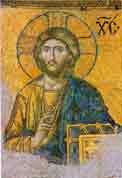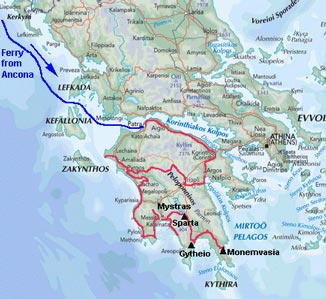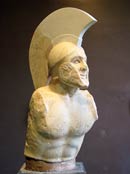OUR GREEK ODYSSEY - Week
6 
Week 6 Photos Bottom of page Return to Index-page
|
Homer recalls that Mycenaean Sparta's king was Menelaos whose wife Helen was abducted by Paris, Prince of Troy, giving rise to the Trojan War. Classical Sparta was sited in the broad fertile valley of the River Evrotas, hemmed in by the Taygetos mountain range to the west and Mount Parnonas to the east. While other Greek cities like Athens experimented with democratic forms of government (albeit only male citizens could vote and slavery was still the norm), Sparta had evolved a highly reactionary militaristic constitution dependent on enslavement of the neighbouring Messinians. The 20th century has produced uncomfortable echoes of Sparta's racially elitist society: eugenetics (only the fittest male infants were allowed to survive), brutal military training, suppression and enslavement of minorities considered 'untermenschen'. The Spartans' arrogant military power enabled them to win wars, but with their introspective culture, they never quite seemed to know what to do with the peace (lessons for modern USA?). But Sparta's defeat by the Thebans in 371 BC, and liberation of the Messinians (repatriated to the new city of Messene visited last week) spelt the death-knell of Sparta's peculiar militaristic society. By the early Christian period, Sparta was no more than scattered farming settlements in the Evrotas valley. In 1249 AD, the Franks took time off from the Crusades to occupy Laconia, and to control their conquests, built a mighty fortress on a 2000 feet high hill close to Sparta called Mystras. As times became more unsettled, the population moved up onto safer ground around the fortress, using the stones of ancient Sparta to built new homes, and all traces of the classical city finally disappeared. The Byzantine Greeks recaptured the new city of Mystras in 1262 and for the next 200 years, Mystras flourished economically, culturally and artistically, eclipsing even Constantinople the capital of the Eastern Empire. Many churches and monasteries were endowed, beautifully decorated with frescoes, and Mystras became a major centre of learning and scholarship. More importantly from our standpoint, commercial interchange with the great trading centres of the West (Florence, Genoa, Venice) also encouraged the spread of learning. Italy's powerful and influential families such as the Medici attracted scholars from Mystras, bringing with them knowledge of classical literature and philosophy. It is therefore to Mystras, with the blossoming of classical learning during the dying years of the Byzantine Empire, that we owe the origins of the Renaissance which so changed the face of Western Europe. The Turkish conquest of Greece in 1460, and the fall of Constantinople, brought all this to an end. Having sown the seeds of the Renaissance which brought such momentous changes across Western Europe, the poor Greeks missed out under a 350 year dark age of barbaric Turkish-Muslim domination (again lessons for the modern world). And so things remained until, soon after Greek liberation and independence, the modern town of Sparti was founded in 1831, down in the valley on the site of the classical city, again re-using building materials from uphill Mystras which by then was in major decline. The stones had come full circle. And we camped halfway between the modern town of Sparti and the village which today bears the name of Mystras. It felt as though for 6 days, we were living through this fascinating span of history. And at night, as if to remind us, the remains of Mystras' mighty Frankish castle were illuminated. Modern Sparti is as unlike its ancient counterpart as could be imagined - a vibrant and civilised provincial town. Contemporary Spartans dress trendily and are courteous and helpful to visitors; even the traffic is relatively benign, and stops to let pedestrians cross the orange-tree lined boulevards. We caught the bus into Sparti for a delightful day in town - where else, while wandering around the stalls of the vegetable market, could you glance up to see 7,000 foot snow-fringed mountains on the sky-line? (see Photo 1). Greece still has an extensive state-operated bus network, serving the outlying villages. We caught the bus up to the village of Anavryti, 2,600 feet up in the Taygetos mountains, by the most remarkable piece of road imaginable, which zig-zagged 2,000 feet up an apparently vertical cliff. This was the relaxed form of mountain walking - catch the bus up to the high point, then return by part of the E4 Trans-European mountain trail, past isolated monasteries, flower-filled high valleys, and finally a hair-raising descent down a 300 foot deep gorge. Our day up at Mystras was truly memorable. Imagine a 2000 foot conical hill, precipitous on 3 sides, with the eastern slopes covered with houses, churches and the narrow lanes of a bustling city. Fortification walls enclosed the higher areas of grand aristocratic mansions and the Despot's (Governor) Palace, and the pinnacle was topped by the original Frankish castle guarding the city spread out below. That's how Mystras would have been in its 15th century Byzantine heyday. Today it is an almost deserted (apart from the daily influx of tourists) archaeological site, overgrown with giant fennel plants and myriads of other wild flowers. The only remaining inhabitants are a few elderly nuns at the last of the monasteries (and a wild tortoise which we met). The once grand mansions are now stark ruins on the hillside, but the remains of the 800 year-old fortress still stand proudly on the summit, and 9 of Mystras' once numerous churches, chapels and monasteries have been restored and their beautiful frescoes preserved. Photo 2 shows the church of St Theodori. The magnificent Despot's Palace is also in process of restoration, and yes Colin, the re-roofing is well underway. All in all, Mystras proved to be a historical and botanical paradise - plenty for us both to remember. After our memorable stay in historical central Laconia, we moved south to Gytheio, once the port of classical Sparta, on the southern coast of the Peloponnese. It is still a busy and delightful little port, from where ferries leave for Crete. Fish-tavernas line the waterfront, where you can select your lunchtime octopus for grilling from those on display (see Photo 3). And so to the most southerly point of this trip - to Monemvasia, Greece's Rock of Gibraltar. It's a geological showpiece - a 1000 ft high limestone outcrop, standing off from the SE Laconian coast connected to the mainland by a causeway. It's also another place with a fascinating history. Not only is the rock a naturally impregnable position, it also strategically overlooked the main sea trade-routes. For 700 years, Monemvasia served as Byzantine Greece's fortified commercial centre, and at its peak the rock had some 50,000 inhabitants. It was also the first fortress to be liberated from the Turks in 1821 at the start of the Greek War of Independence. Today little remains of the former city atop the rock apart from the amazing fortification walls, one surviving Byzantine church and traces of the cisterns which gathered rainwater for times of siege. Like Mystras, the ruins are now completely overgrown - but enough historical, geological and botanical wealth to keep us both busy for a day. Photo 4 shows Monemvasia viewed from our campsite further down the coast. We are now past the half-way point of this trip, and from here, it's northwards all the way. Next week, back to Argolis and to the Isthmus of Corinth. Sheila and Paul Published: Tuesday 18 May
|
 Week
6 news: Laconia - lessons from history
Week
6 news: Laconia - lessons from history